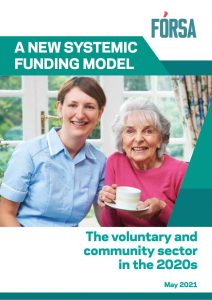New report recommends new funding model for community and voluntary sector to stop ‘talent flight’
A new report about the delivery of health services by the community and voluntary sector in Ireland has found that very high annual staff exit rates, up to 33% annually, is leading to a decline in the quality of service delivery.
The report launched today (Tuesday) by Fórsa trade union, A New Systemic Funding Model: The voluntary and community sector in the 2020s, examines the need to rebuild and refinance the voluntary and community sector with a more sustainable and appropriate funding model. The report was written by researcher Brian Harvey.
The sector provides a range of vital services to people with disabilities and older people, funded by section 39 of the Health Act. Services to people experiencing homeless are funded through section 10 of the Housing Act, while ‘Section 56’ organisations that provide services to children are funded by the
Department of Children, Equality, Disability, Integration and Youth via Tusla.
The report identifies a significant ‘talent flight’ as staff seek better terms and conditions of employment in the HSE and other services, while costs are driven up by the additional recruitment activity necessitated when staff move on.
Fórsa’s report also looks at the implications of the continuing disparity in employment terms between health workers in the community and voluntary sector and those directly employed by the HSE. The report identifies a significant ‘talent flight’ as staff seek better terms and conditions of employment in the HSE and other services, while costs are driven up by the additional recruitment activity necessitated when staff move on.
Fórsa official Catherine Keogh said a survey of Fórsa members for the report revealed a widespread sense of anxiety, anger and resignation among workers in the sector: “These workers experience a significant increase in workload each year, even before we consider the additional pressure brought on by the Covid pandemic.
“Workers throughout the sector are feeling frustrated with the current system. Pay scales and conditions vary considerably from one organisation to the next, which means that workers who do the same job are treated differently and paid less depending on where they work.
“The disparity in terms and conditions between these agencies and the alternatives, such as direct employment by the HSE or in the private sector, has led to a situation where the talent flight of staff has become a real problem. Annually, this is about a third of staff from these organisations. Employers are often left in competition with the HSE to hold onto their most experienced and knowledgeable staff.
“Employers in the sector do recognise this as a serious challenge. Retaining staff, and attracting new staff, has become an issue of grave concern. Fórsa’s research shows that there would be serious gains for their organisations if parity of terms and conditions could be achieved through the implementation of a new funding model.
“Other benefits of a new funding model would include more successful recruitment and retention, in addition to reduced costs, improved services and better planning,” she said.
The research identified two distinct labour markets in these services, with an identifiable pattern of staff movement from Section 39 and Section 10 employments to other agencies. The report says the community and voluntary sector has become a career “stepping stone” as the flight of workers from the sector continues, while the survey also revealed a distinct sense of non-attachment for some workers to their job.
A new funding model would ensure that the community and voluntary sector could secure an experienced staff who stay longer in their jobs, which would improve services in the longer term.
Ms Keogh said while the pay restoration process has seen some improvement, it remains incomplete, while the financial situation of many of the voluntary organisations affected remains dire: “Disparity of pay and conditions can’t be seen in isolation, but as part of a broader set of problems affecting the voluntary sector.
“Voluntary organisations have stressed how multi-annual funding is the most effective way to provide some certainty for those organisations and their staff, and to address the specific challenges they’re facing. This would help to secure parity of pay conditions across the sector, the benefits of which are successful recruitment and retention of staff, in addition to improved morale.
“A new funding model would ensure that the community and voluntary sector could secure an experienced staff who stay longer in their jobs, which would improve services in the longer term,” she said.
You can download a full copy of the report by clicking on the icon below.
Representing over 30,000 health workers including health and social care professionals, clerical, administrative, management and technical staff. We consider it one of the many strengths of the union that our members are central to the delivery the full array of health and welfare services in Ireland. To find out more about the range of grades represented, and where they operate within those services, visit our map “At the heart of Health and Welfare.”


